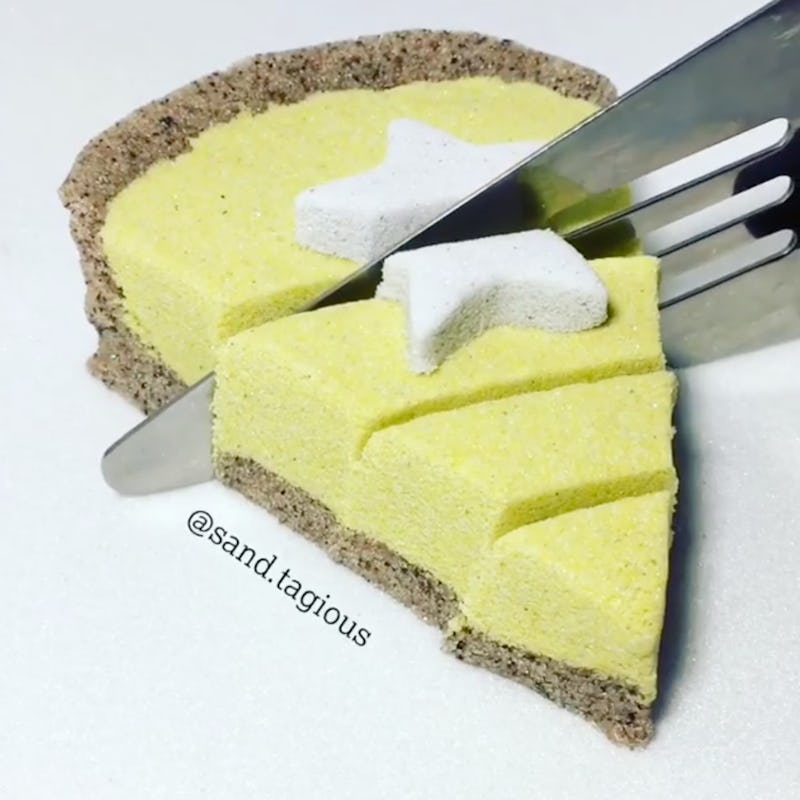Why the ASMR Community Is Debating the Popular "Slicing Sand" Videos
Are trends overtaking the ASMR genre?

If you’ve seen videos of kinetic sand formations being sliced with a satisfying crunch on your Instagram Explore page, it’s not just an art demonstration. You’re witnessing one of the newest “oddly satisfying” trends that populate places like the subreddit of the same name, craft stores supplying slime materials to middle schoolers, and now, the YouTube ASMR community.
But while videos tagged with #asmr, #asmrsand, and #oddlysatisfying are growing ever more popular on platforms like Instagram and YouTube, die-hard members of the ASMR community are tentatively wondering whether search prioritization for trends fated to go out of style will bring the relaxation genre down with it.
What Is ASMR, Slime, and Sand All About, Anyways?
ASMR isn’t so much of a trend as a niche subculture that’s slowly been gaining notoriety on mainstream social media circles. The letters stand for “autonomous sensory meridian response,” a pseudoscientific term crafted by its early pioneers to describe the tingling, calming sensation that arises for some people when they watch videos with ASMR “triggers.”
Those triggers can include videos of “ASMRtists” tapping on objects with their fingernails, breathing into a sensitive microphone, whispering into the camera, and roleplaying real-life scenarios like haircuts, ear cleaning, and doctor’s appointments with their audience.
If it sounds weird, just know that millions of people who subscribers to creators like ASMR Darling, Gibi ASMR, and Maria GentleWhispering think it works great as a sleep aid and relaxation tool. The “tingles” ASMR hobbyists get in response feel almost like goosebumps on their brains, or calming waves of comfort that sweep over their skin.
But when it comes to sand, slime, and visual stimuli, the crossover between ASMR and trendy Instagram aesthetics starts to blur. In the ASMR subreddit, the largest gathering for ASMR-related discussion on the internet, some members have expressed confusion and concern with the way creators and their audiences have monetized the practice and turned into a search algorithm game.
While it’s true that almost anything can be an ASMR trigger, from listening to a teacher in class IRL to watching a YouTuber pat their face with a beauty blender, videos, photos, and GIFs that focus more on DIY projects and sand artistry sway more toward appreciation, rather than tingles.
The question looms: do these sand and slime videos even cause triggers, or do they just look pretty?
Why Can’t ASMR and Instagram Aesthetics Co-Habitate Peacefully?
In one r/ASMR discussion this month titled “How is ‘Satisfying Slime ASMR’ so popular?” the original poster wonders how a channel with such low production value, distracting background noise, and little variety or attention to classic triggers could gain so many subscribers (2.2 million and counting, the first ASMR-associated channel to breach the 2 million mark).
The responses come to the conclusion that, since slime has been a huge boom, both economically and on social media platforms, for the middle schooler market especially, YouTube’s search algorithm prioritized a channel with both “ASMR,” a growing trend, and “slime,” a similar search phenomenon, in the title. But the videos are distinctly counterproductive for ASMR enthusiasts seeking tingles, and slime on its own is a rare trigger to start with.
The recent popularity of sand cutting, on YouTube — but primarily in quick Instagram videos — has a little more in common with widely recognized ASMR triggers. The creator behind “sand.tagious,” an Instagram account with almost a million followers, keeps the background free of distracting noises and focuses in on both the visual and auditory stimuli associated with the cutting. The satisfying crunch, along with the mix of colorful sand patterns, exquisitely crafted shapes, and premium audio and camera quality make for a smooth meld of both oddly satisfying and traditional ASMR content.
There’s still a persistent worry from the ASMR community that, as social media influencers looking to maximize views and profit set into the field of relaxation triggers, there will be an overall decrease in quality.
Once ASMR becomes a YouTuber’s field, the focus becomes more on creating advertiser-friendly content with a pretty (usually female) face and short, monetized sessions, as opposed to the ASMR days of old, when creators regularly posted hour-long videos that catered to the consumers.
But as other members of the community pointed out, the original niche group of enthusiasts isn’t going anywhere, and ASMRtists who run their channels with that audience in mind will continue to post tingle-worthy triggers.
See also: China Just Banned ASMR Relaxation Videos for Being ‘Vulgar and Pornographic Content’